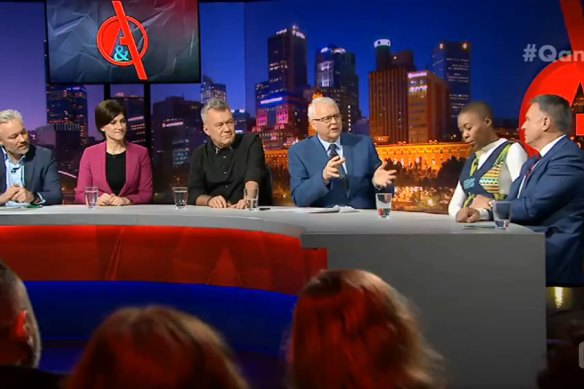What next for Q+A, if not the end?
By Calum Jaspan
Each year, the outlook for Q+A gets even bleaker, and new analysis of audience figures indicates the once-vaunted show’s move back to Monday nights might not have been the ratings booster the national broadcaster had hoped it would be.
The ABC has spent years trying to make the show work, finding new hosts and new timeslots, but more recently audiences have been declining at a significant rate.

In its heyday, Q+A was a must-watch television show for many Australians.
After 10 years running on a Monday night, the program moved to Thursdays at the end of 2020. Director of the ABC’s entertainment and specialist division, Michael Carrington said at the time the broadcaster discovered audiences “now look for content elsewhere around 9pm”, justifying the show’s move to an 8.30pm prime-time slot on Thursdays.
“Some still watch the ABC but others might watch a [subscription] streaming service. In an era of declining budgets, we want to use the money we have to attract and engage the biggest audiences.”
The show’s audiences took a sharp fall in its Thursday run. The first eight shows in 2021 averaged a metro audience of 250,000, a sharp decline from 468,000 in a COVID-boosted 2020 and 408,000 the year prior.
After appointing Stan Grant as the show’s sole host, Q+A was moved back to Mondays at the start of 2023, capping off its strongest run of the week in 7.30, Australian Story, Four Corners, and Media Watch in the hope some of that audience might bleed back through.
Sadly for Q+A, it hasn’t worked, and its audience continues to hit new lows in 2023. Last week, its metro audience was a jaw-dropping 84,000.
True, that episode ran at the same time as a game featuring the bulldozing Matildas, but Q+A’s comparative decline on its broadcast two weeks prior was twice what its Monday night stablemates in Four Corners and Media Watch experienced.
The issue isn’t limited to just Q+A. Audiences continue to decline across the ABC, as well as on commercial television, yet the issue is particularly pronounced for the once-influential panel show.
In 2023 so far, the show averages a metro audience of 205,000, down from 228,000 in 2022.
Add that to Grant quitting as the show’s host less than a year into the role, with Patricia Karvelas appointed only until the end of the year, the outlook for Q+A is a head scratcher.
So, why is the ABC persisting with it?
The broadcaster has been clear audiences are shifting online, though in the case of Q+A, they’re shifting elsewhere entirely. The show took a month-long winter hiatus this year, and few took notice.
In its return episode on July 24, the overnight streaming audience on its iView platform was just 8000. In the seven days after the show aired, 12,000 more watched it on catch-up.
The total overnight audience (including metro, regional and BVOD) for Four Corners on the night was 385,000, with 386,000 joining for Media Watch. Following Paul Barry’s sign-off, 44 per cent of the audience switched off, the figure dropping to 216,000.
In 2020, when the show last aired on Mondays, during the eight-week run referenced earlier, the average drop-off after Media Watch was 23 per cent.
Malcolm Turnbull, former prime minister and Q+A aficionado says while the show always worked under its first host, Tony Jones, getting the panel right was always the most important factor.
“It looks easy, but getting the right mix is the difference between having an interesting and boring dinner party.”
“People need to spark off each other.”
He himself came up against The Australian’s Paul Kelly in 2020, taking aim at News Corp over its approach to climate action.
“The reality is, News Corp and Murdoch have done enormous damage to western democracy and in particular to the United States and Australia, and in particular on the subject of global warming.”
That particular episode had a metro audience of 488,000 viewers.
“Tony was a superb host, and nobody that came after could hold a candle to him in terms of ability,” Turnbull says, adding his authority, humour and tendency to get a rise from guests without being rude formed a deadly combination.
“It’s easy to do until you try and do.
“All those since are talented broadcasters, but the reality is none did as good a job, with all due respect to them.”
As Carrington said, the ABC has been clear on reducing spend on programming post-9.30pm, the show’s move back to Mondays “a sign they are filling a hole”, a former senior ABC executive tells this masthead, speaking on condition of anonymity.
The audience justification is no longer there, they say, the only reason it hasn’t been cut being the ongoing noise around axing.
Hamish McDonald was the show’s first host after Tony Jones, quitting after 18 months, citing abuse across Twitter and Instagram.
Grant too, quit the role this year for similar reasons – albeit not directly related to Q+A – but his reluctance to return to the format was telling.
The ABC has been clear Karvelas is only in until the end of the year, with a permanent appointment looking ever more unlikely.
The broadcaster has previously come out swinging in defence of Q+A, its hosts, the value it offers and the audience that watches it.
When several questions were put to it this week on the show, it declined to comment.
The Business Briefing newsletter delivers major stories, exclusive coverage and expert opinion. Sign up to get it every weekday morning.